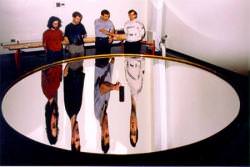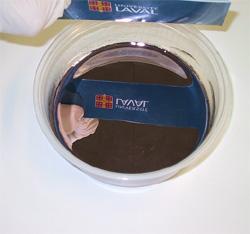Some astronomers feel that rotating liquid mirror telescopes (LMT) may revolutionize astronomy. LMTs work because the basic laws of nature — gravity and centrifugal force — conspire together to give LMTs the perfect, parabolic shape needed for astronomical observing. And unlike ordinary telescopes with glass mirrors that are expensive to make and maintain, LMTs are quite cost effective because of low construction costs (current estimates have liquid mirrors at 1% the cost of a glass mirror) and they don’t need to be polished or housed in an expensive mount.
Ermanno Borra from Canada is one of the foremost experts on LMTs, and he has been constructing and testing different types of these telescopes since the early 1980’s. His latest research involves creating a tiltable LMT — previously thought to be almost impossible — by using a thin, reflective layer of self-assembling metallic nanoparticles.
LMTs are made by spinning a reflective liquid, usually mercury, on a bowl-shaped platform to form a parabolic surface, perfect for astronomical optics. A handful of LMTs are being used today, including a 6-meter LMT in Vancouver, Canada, and a 3-meter version that NASA uses for its Orbital Debris Observatory in New Mexico.
Borra and his colleagues have been experimenting by using different liquids to create LMTs, since part of their research has been geared toward studying the feasibility of constructing a large LMT on the Moon, and mercury freezes at temperatures found at the lunar poles. Since low temperature liquids like small hydrocarbons (such as ethane) are not shiny, Borra has been trying to deposit a reflective metal on the surface of these liquids. In 2007 Borra and his team successfully coated a low temperature ionic liquid (contains essentially only ions, such as ethylammonium nitrate) with silver by vaporizing it in a vacuum, something that’s never been done before in the field of optics.
But more recently, Borra’s team has used silver nano-particles known as Metal Liquid-Like Films, or MELLFs to coat hydrophilic (water bondable) liquids like ethylene glycol. In a recent paper outlining their research, the team says this is a significant improvement over their previous work where the reflecting layer was deposited on hydrophobic (water resistant) oils. Usually, creating MELLFs is very labor intensive and time consuming. But the team even created a small, simple, motorized, computer-controlled MELLF machine and can now make enough MELLF for a 1 meter mirror in about 30 hours. Through further tests and trials, the team found that spraying the highly reflecting MELLFs on the surface of the hydrophilic liquid produces the best results.
Usually, liquid mirrors have the limitation of that they can only point straight up, so it’s not like a standard telescope that can be pointed in any direction and track objects in the sky. It only looks at the area of sky that is directly overhead. But Borra has been working on creating a tiltable LMT, and by using the MELLF nanoparticles, has now been successful in producing an LMT that can be tilted 45 arc seconds.
Their goal is to be able to tilt the LMT by 10 degrees. To do this, they must find a higher viscosity hydrophilic liquid, which might have them returning again to try ionic liquids, of which there are wide variety to choose from.
“It will be worthwhile making the effort because, based on our experience so far, tiltable liquid mirrors promise to be very inexpensive and easy to make, ushering in an era of inexpensive telescopes and readily available telescope time.”
–from a paper by Borra, Gagne and Ritcey providing an update on their LMT research
A liquid mirror envisioned for a lunar telescope would be 20 to 100 meters in diameter, making it up to 1,000 times more sensitive than the proposed next generation of space telescopes. As Borra and his team continue their research, look for more updates from their work in the future.
Original News Source: Astronomy & Astrophysics


